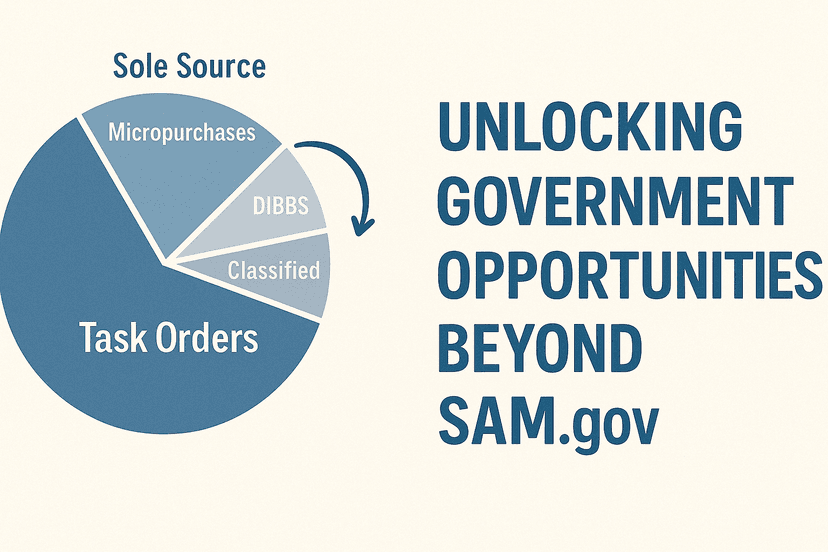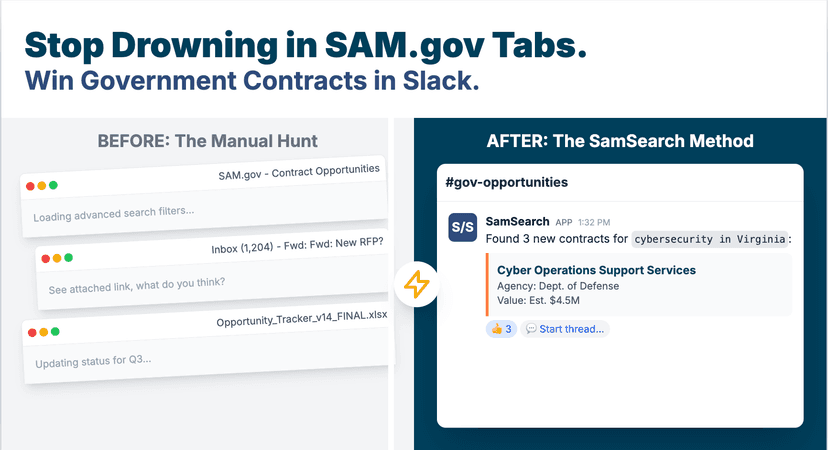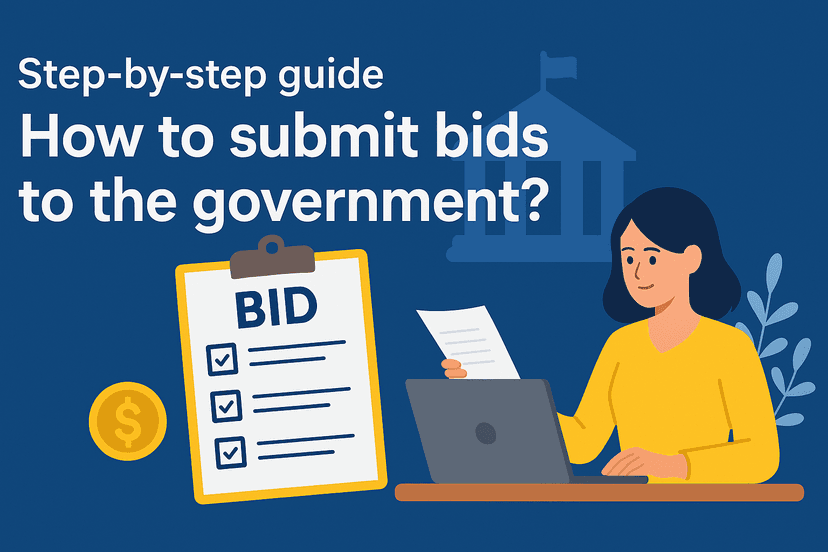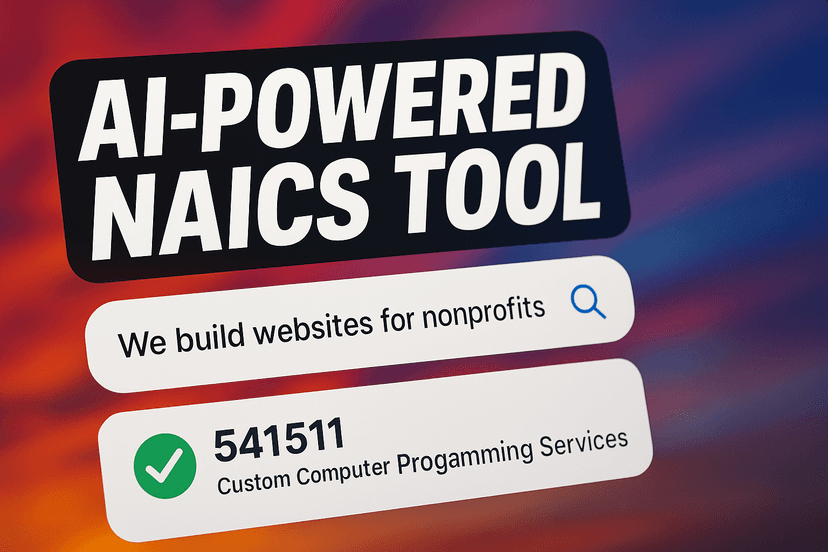How Capture Agencies Are Using AI to Land More Government Contracts in 2025
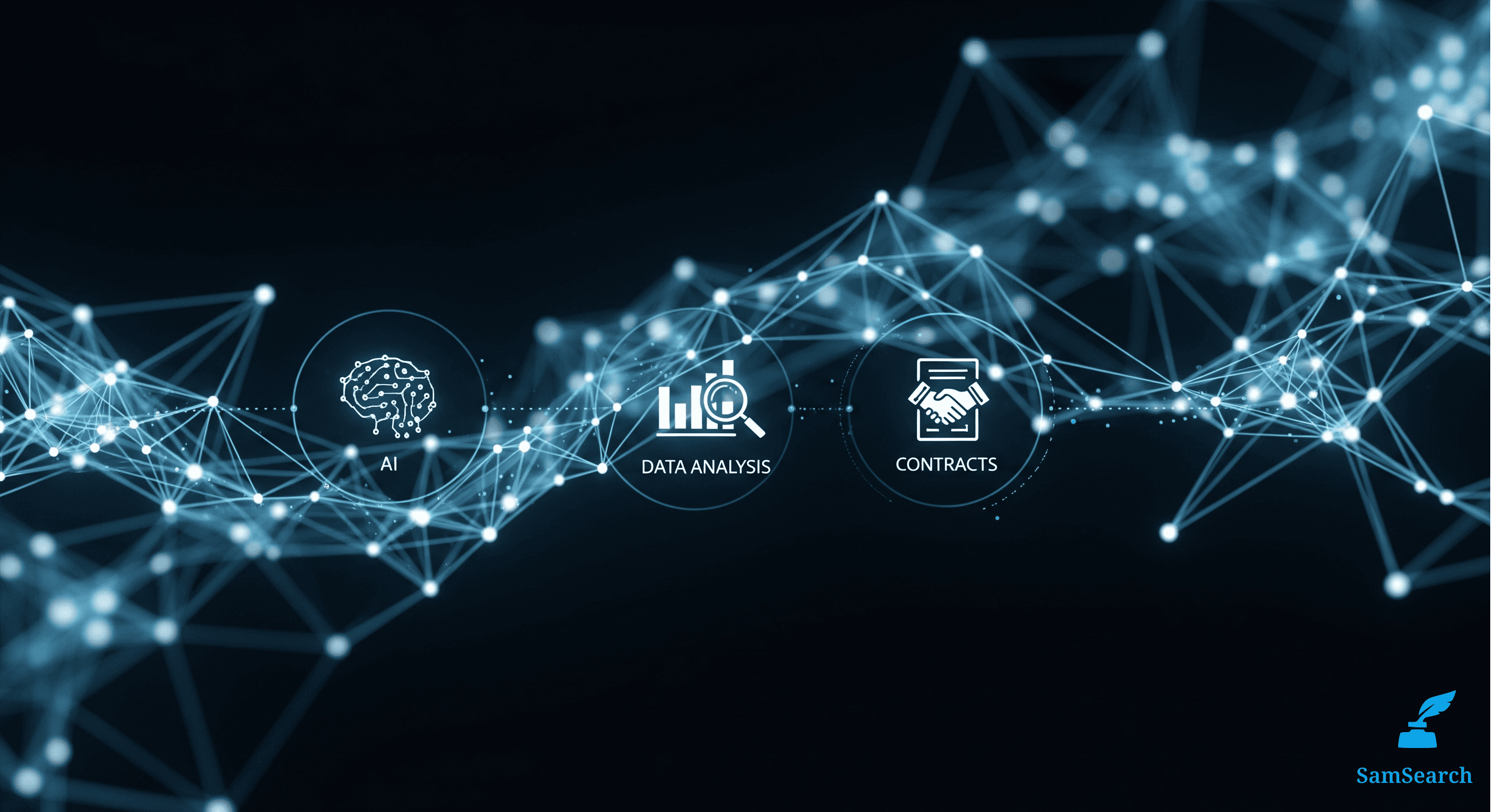
How Capture Agencies Are Using AI to Land More Government Contracts in 2025
Introduction: The High-Stakes Game of Government Contracting is Changing
The U.S. federal government represents one of the most stable and lucrative markets in the world, awarding contracts worth nearly $700 billion in a single recent year.1 These
high-value, long-term agreements offer a level of stability that is hard to find in the commercial sector.2 However, this immense opportunity attracts equally intense competition, creating a high-pressure environment where every bid is critical. The reality for many government contractors (GovCon) is one of diminishing returns;
win rates are shrinking, with three-quarters of firms reporting a success rate of 50% or less.1 In this landscape, simply responding to a Request for Proposal (RFP) is a recipe for failure.
The key to tilting the odds lies in a discipline known as "capture management"—the art and science of winning a contract long before the formal proposal is ever submitted. Industry veterans agree that between 40% and 80% of an agency's buying decision is made during this pre-proposal phase.3 It is a strategic process of intelligence gathering, relationship building, and positioning that separates the most successful contractors from the rest. Yet, the traditional methods of capture are buckling under the weight of modern demands.
As we move through 2025, the federal procurement landscape is undergoing its most significant transformation in a generation, driven by a government-wide mandate for efficiency, accountability, and the aggressive adoption of Artificial Intelligence (AI).4 Federal agencies are not just encouraging AI; they are actively using it to define requirements, evaluate vendors, and manage acquisitions. For contractors still relying on manual research, disconnected spreadsheets, and gut-feel decision-making, the gap between their capabilities and the market's expectations is becoming a chasm. They are not just at risk of being inefficient; they are at risk of becoming irrelevant.
This playbook provides a definitive analysis of this new reality. It will dissect the foundational challenges of traditional capture management, explore the AI-centric policy and technology shifts within the federal government, and deliver a practical roadmap for how leading capture agencies are leveraging intelligent tools like SamSearch to dominate the 2025 GovCon market.
Section 1: The Grinding Reality of Traditional Capture Management
To understand the revolutionary impact of AI, one must first appreciate the immense and often frustrating effort involved in traditional capture management. It is a discipline that demands strategic foresight but is frequently bogged down by manual, low-value tasks.
What is Capture? The Art of Winning Before the Game Begins
Capture planning is the structured, proactive process of preparing to win a specific government opportunity before a formal solicitation is released.6 It is the critical link between business intelligence and a winning proposal strategy, serving as the government market's equivalent to pre-sales for complex commercial deals.3 While the concept is established, its recognition as a formal profession is relatively recent, emerging primarily since the 1990s.3 Consequently, many organizations lack documented, repeatable processes, and practitioners often learn on the job without formal training, leading to inconsistent execution and results.7
The core activities of capture involve gathering deep intelligence on the customer agency, assessing the competitive landscape, evaluating one's own capabilities against the anticipated requirements, building influential relationships, and developing a strategy that positions the company as the undeniable best choice.6
The High Cost of "Flying Blind": Why Capture is Non-Negotiable
Attempting to win federal contracts without a robust capture plan is not a strategy; it is a gamble.3 It forces a company into a reactive posture, scrambling to respond to RFPs they are ill-prepared to win. The most successful contractors understand this reality and invest accordingly. Companies boasting high win rates (upwards of 70%) consistently spend approximately
60% of their business development and proposal (B&P) budgets on capture activities, with only 40% allocated to the proposal itself.3
This upfront investment is crucial for avoiding one of the biggest drains on a contractor's resources: wasting precious B&P funds pursuing unwinnable deals.2 For small and mid-sized businesses with limited resources, the ability to effectively qualify opportunities early is not just a matter of efficiency but of survival.
The Four Horsemen of Capture Frustration (The Pain Points)
While the principles of capture are sound, their manual execution is fraught with challenges that hamstring even the most dedicated teams. These pain points represent the daily grind for countless capture managers.
1. Data Overload & Disparate Sources
Capture managers are tasked with being strategists, but they are often forced to act as data archivists. They are drowning in a sea of information that is being published "every second of every day". This intelligence is scattered across a multitude of disconnected sources: official portals like SAM.gov, historical award databases like the Federal Procurement Data System (FPDS), Government-Wide Acquisition Contracts (GWACs), potential teaming partners' inputs, and internal records. The default tool for consolidating this information is often a spreadsheet, a static document that becomes outdated the moment it is saved. This forces capture professionals to spend an inordinate amount of time simply compiling data rather than analyzing it.
2. The Time Sink of Manual Analysis
The capture process is notoriously long, with a typical cycle lasting 12 to 24 months and some complex procurements taking up to five years to position for.3 A significant portion of this time is consumed by manual analysis. Capture managers must "wade through huge volumes of data" and sift through "a lot of clutter" just to identify a list of potential prospects.1 For each of these prospects, they must then download and meticulously read massive PDF documents—RFIs, sources sought notices, and draft RFPs—a process that can take hours for a single opportunity just to make a preliminary assessment.8
3. The High Risk of Poor Bid/No-Bid Decisions
Without a structured, data-driven framework, critical bid/no-bid decisions are often based on gut feelings and incomplete information. This leads to what industry experts call "boiling the ocean"—expending excessive resources pursuing opportunities that are a poor fit for the company's core capabilities or strategic goals.9 This misallocation of resources not only wastes money but also leads to the submission of subpar proposals, which can cause significant reputational damage within the federal market.9 The internal "Gate Review" process, where executives ask fundamental questions like "Can we do the work?" and "Can we build a winning team?", becomes a subjective exercise rather than a rigorous, fact-based evaluation.2
4. The Challenge of "Shaping the Opportunity"
The ultimate goal of capture is not just to respond to an RFP, but to influence its creation. This is known as "shaping the opportunity".2 It involves building deep customer intimacy, understanding an agency's pain points, and providing valuable insights—often through white papers or technical discussions—that guide the agency's requirements toward your company's strengths.2 This requires significant "face time" and "walking the halls" to build relationships with key decision-makers.2 However, this is nearly impossible to do at scale when the intelligence-gathering process is manual. Without an efficient way to know who to talk to, what their specific challenges are, and what to say, this crucial strategic activity becomes inefficient and ineffective.
Section 2: The AI Tsunami: How Washington is Embracing Intelligent Automation in 2025
The challenges of traditional capture are colliding with a powerful new force: the federal government's own aggressive adoption of Artificial Intelligence. This is not a distant trend; it is a present-day reality that is fundamentally altering the rules of engagement. In 2025, AI is not just a tool for contractors; it is a core component of the government's own procurement strategy, creating an urgent need for vendors to adapt.
A New Mandate from the Top
The push for AI adoption is coming directly from the highest levels of government. The White House has established a clear policy directive with a "forward-leaning, pro-innovation, and pro-competition mindset" regarding AI. This policy is codified in specific directives, such as the Office of Management and Budget (OMB) Memoranda M-25-21 and M-25-22, which instruct federal agencies to accelerate their use of AI and drive more efficient AI acquisition.11
This mandate is being driven by a focus on eliminating waste and enforcing measurable value. Agencies are being pushed to favor vendors who can demonstrate automation, scale, and speed, with a heavier emphasis on data-driven justifications and proven return on investment even before a contract is awarded.4 This systemic shift means contractors are no longer just selling services; they are selling efficiency and technological alignment with federal priorities.
Putting Money Where the Mandate Is: The Government as an AI Customer
The government's commitment to AI is most evident in its spending. Federal agencies are making massive investments in AI capabilities, signaling to the market that this is a top priority. A prime example is the Pentagon's Chief Digital and Artificial Intelligence Office (CDAO), which recently awarded multiple contracts with ceilings of up to $200 million each to leading U.S. frontier AI companies, including OpenAI, Google, Anthropic, and xAI.12 These contracts are designed to accelerate the DoD's adoption of the most advanced AI models for critical national security challenges.13
Simultaneously, the General Services Administration (GSA) is making these powerful technologies readily available across the entire government. The GSA has added premier AI solutions like OpenAI's ChatGPT, Google's Gemini, and Anthropic's Claude to its Multiple Award Schedule (MAS), streamlining procurement for all federal agencies.15 In a landmark move, the GSA even brokered a
"OneGov" partnership with OpenAI to provide ChatGPT Enterprise access to agencies for a nominal fee of $1, a clear signal of the government's intent to achieve universal AI adoption.11
The Government is Using AI to Buy: A New Kind of Customer
Crucially, agencies are not just buying AI; they are embedding it into the very fabric of the procurement process. This means contractors are increasingly selling to human contracting officers who are augmented by intelligent systems. The implications are profound.
Consider these real-world examples:
-
The U.S. Army developed DORA (Determination of Responsibility Assistant), a bot that automates vendor background checks, reducing a process that took an hour manually to less than five minutes.16
-
The IRS uses an AI-powered Contract Clause Review Tool that identifies missing or incorrect clauses in solicitations, cutting review times from six hours to six minutes.
-
The Department of Health and Human Services (HHS) deployed its "Accelerate" platform, which uses AI and machine learning to analyze contract data, identify price discrepancies, and monitor contractor performance across the entire department.16
-
The DoD is actively building an AI-powered contract writing system to help its personnel rapidly generate high-quality solicitations and other procurement documents.
This symbiotic AI loop—where the government uses AI to buy and contractors must use AI to sell—creates a new competitive imperative. The RFPs themselves are becoming more data-driven, structured, and consistent, shaped by the same AI technologies that agencies are procuring. A contractor using manual methods may fail to detect the subtle keyword patterns, thematic priorities, or structural cues embedded in an AI-assisted solicitation. In contrast, a contractor using a sophisticated AI platform is equipped to speak the same "digital language" as their customer, creating proposals that are perfectly tuned for evaluation by the government's own AI-augmented review systems. This is no longer a simple efficiency gain; it is a fundamental strategic advantage.
Section 3: The AI-Powered Capture Agency: From Reactive to Predictive
The convergence of traditional capture challenges and the government's AI mandate creates a clear opportunity. AI-powered tools are not just improving the existing capture process; they are transforming it, enabling a shift from slow, reactive, and subjective methods to a fast, predictive, and data-driven approach. By mapping the pain points of traditional capture to specific AI-driven solutions, the path to a higher probability of win (PWin) becomes clear.
Transformation 1: From Keyword Guesswork to Semantic Intelligence
The Old Way: A primary frustration for any contractor is finding the right opportunities. Traditional search on platforms like SAM.gov relies on rigid keyword matching.17 A user must know the precise government jargon, acronyms, and North American Industry Classification System (NAICS) codes to find relevant listings. A search for "cybersecurity services" might completely miss a multi-million dollar contract titled "enterprise information assurance support." This is the "literal match" problem, where the system cannot understand the user's intent, only the specific words they type.
The AI-Powered Way: Modern AI platforms utilize semantic search. This technology goes beyond keywords to understand the intent and context behind a query. It recognizes that "IT modernization," "cloud migration," and "digital transformation services" are conceptually related, even if the exact words differ. It understands the user's goal, not just their vocabulary.
SamSearch in Action: This is precisely the technology behind SamSearch's Natural Language Understanding. It allows users to "search using plain English" and describe what they are looking for conversationally, without needing to master the complex lexicon of "contracting-ese". This single capability breaks down the biggest barrier to discovery, dramatically expanding the pipeline of relevant opportunities that would have otherwise been missed.
Transformation 2: From Hours of Reading to Instant Insight
The Old Way: Once a potential opportunity is identified, the real work begins. A capture manager must download and manually read through a dense RFP or solicitation document, which can easily exceed 20, 50, or even 100 pages.8 This laborious process must be repeated for every single opportunity in the pipeline, consuming hundreds of hours just to make initial bid/no-bid decisions.
The AI-Powered Way: Generative AI excels at "intelligent data capture and extraction".18 An AI model can ingest and digest these lengthy documents in seconds, identifying and summarizing the most critical information: the scope of work, eligibility requirements, key deadlines, and potential red flags.
SamSearch in Action: This is the function of SamSearch's "AI-Generated Contract Summaries." The platform instantly provides a fast, clear, and concise overview of each opportunity, allowing a capture manager to make a confident and informed bid/no-bid decision "in seconds, not hours". This directly attacks the manual analysis pain point, freeing up enormous amounts of time for higher-value strategic activities.
Transformation 3: From Gut-Feel to Data-Driven PWin
The Old Way: Calculating the Probability of Win (PWin) has historically been a subjective art, heavily reliant on a capture manager's personal experience and intuition. Conducting a proper competitive analysis involves painstaking manual research on FPDS, trying to piece together disparate data points about incumbent contractors, their past awards, agency spending habits, and potential teammates.
The AI-Powered Way: AI platforms can analyze vast datasets of historical awards, agency budgets, and competitor profiles at a scale no human could replicate. They can instantly identify an incumbent's potential weaknesses (e.g., performance issues noted in CPARS), pinpoint recurring procurement cycles, and even suggest ideal teaming partners based on capability gaps and past successful collaborations.2
SamSearch in Action: SamSearch's "Chat with Opportunities" feature transforms this entire process. Instead of conducting laborious research, a user can simply ask the AI direct questions about a specific opportunity, such as, "Who are the top five contractors for this type of work at the Department of Veterans Affairs?" or "Show me similar contracts awarded in the last three years." The AI analyzes all attached files and its vast database of historical contract data to provide instant, data-backed answers.19 This turns competitive intelligence from a multi-day research project into a simple, five-minute conversation.
Transformation 4: From Scattered Spreadsheets to an Integrated Pipeline
The Old Way: The management of capture activities is often a chaotic affair. Critical information—schedules, customer contact notes, competitive intelligence, teaming discussions, and proposal tasks—is scattered across a patchwork of disconnected spreadsheets, Word documents, and email threads. This creates a nightmare for collaboration and accountability, with no central source of truth.
The AI-Powered Way: Modern Software-as-a-Service (SaaS) tools provide a single, integrated, and automated platform to manage the entire government sales lifecycle. These systems create a trackable record for every activity, enhancing collaboration and ensuring that nothing falls through the cracks.
SamSearch in Action: SamSearch's "Journey Hub" provides exactly this solution. It streamlines the entire contract journey with visual project management pipelines, Kanban-style task boards, and integrated stakeholder management.19 It creates the unified, collaborative system of record that is impossible to achieve with traditional, fragmented tools.
Table 1: The Evolution of Capture: Traditional vs. AI-Powered
The following table provides a clear, at-a-glance summary of how AI-powered platforms are revolutionizing each core activity within the capture management process.
Capture ActivityTraditional Method (The Pain)AI-Powered Method with SamSearch (The Gain)Opportunity DiscoveryManual, keyword-based searches on SAM.gov. Relies on knowing specific jargon and codes. Misses conceptually related opportunities.Natural Language Search: Use plain English to find opportunities based on intent and context, not just keywords. Uncover a wider range of relevant contracts.Opportunity Qualification
Downloading and reading dozens of lengthy RFP/solicitation PDFs. Hours spent per opportunity just for an initial bid/no-bid decision. 8
AI-Generated Summaries: Get instant, concise summaries of scope, requirements, and deadlines. Make confident bid/no-bid decisions in seconds.Competitive IntelligenceLaborious manual research on FPDS. Trying to connect the dots on incumbents, past awards, and agency spending patterns. Highly subjective.
"Chat with Opportunities": Ask the AI direct questions about competitors, similar awarded contracts, and potential subcontractors. Get data-driven answers instantly. 19
Teaming & Strategy
Relies on existing networks and ad-hoc research. Difficult to identify new partners or assess incumbent weaknesses systematically. 9
Generative AI Recommendations: AI analyzes your company profile and suggests top-fit opportunities and potential teaming partners based on data, not just relationships.Pipeline ManagementDisconnected spreadsheets, Word documents, and email chains. No central source of truth, poor collaboration, and lack of accountability.
Integrated Journey Hub: Manage the entire lifecycle in one place with Kanban boards, task management, and stakeholder tracking. A single, collaborative system of record. 19
Section 4: Building Your Human-AI Workflow for 2025 and Beyond
Successfully navigating the new GovCon landscape requires more than just purchasing a new piece of software. It demands a strategic integration of AI into the very workflow of the capture and business development teams. This involves a shift in mindset, investment in the right tools, and a commitment to developing new skills.
Adopt an AI-First Mindset: Augment, Don't Replace
The most critical shift is understanding that AI is a tool to augment human expertise, not replace it.4 The goal is to create a symbiotic relationship where AI handles the low-value, repetitive, and data-intensive tasks that consume the majority of a capture manager's time. This includes initial opportunity discovery, document summarization, compliance checking, and historical data analysis.4
By automating this work, AI liberates human experts to focus on the high-value strategic tasks that machines cannot perform: building trusted relationships with agency stakeholders, understanding the subtle political and organizational dynamics of a procurement, designing creative and compelling solutions, and leading complex negotiations.4 The true return on investment from AI is the strategic reallocation of expert human capital. The capture manager evolves from a data miner into a data-driven strategist, spending less time on research and more time on the "face time" and relationship building that ultimately shapes opportunities and wins contracts.2
Invest in a Centralized AI Platform
The era of relying on a patchwork of free government websites, disconnected spreadsheets, and manual processes is over. In a market where competitors are leveraging integrated AI, this approach is no longer viable. A dedicated, centralized AI platform is now a strategic imperative. The question for business leaders is no longer "Can we afford a tool like SamSearch?" but rather, "Can we afford not to have it when our competition does?". A unified platform provides a single source of truth, ensures data consistency, enhances collaboration, and provides the analytical horsepower needed to compete effectively.
Develop New Skills: From Data Miners to Data Strategists
The role of the capture manager is evolving, and so must their skillset. To maximize the value of AI tools, teams need to cultivate new competencies.23 This includes:
-
Data Analysis: While the AI will perform the heavy lifting, capture managers must be able to interpret the outputs, identify trends, and translate data-driven insights into actionable strategies.
-
Prompt Engineering: Learning how to "ask" the AI the right questions is a critical new skill. The quality of the AI's output is directly related to the quality of the human's input.
-
Change Management: Successfully integrating any new technology into an organization requires strong change management. Leaders must champion the new tools, provide adequate training, and redesign workflows to incorporate AI effectively.
Prioritize Data-Driven Storytelling
In an AI-driven procurement environment, proposals must be more than just compliant; they must be compelling. The insights generated by AI tools should be used to craft a powerful, data-backed narrative that speaks directly to the agency's stated and unstated needs. Instead of making generic claims, contractors can use AI-derived intelligence to embed quantifiable value propositions directly into their proposals. For example, a proposal might state, "Our automated solution will reduce your agency's document processing time by an estimated 40%, directly supporting the efficiency goals outlined in OMB Memorandum M-25-21." This approach demonstrates a deep understanding of the customer's priorities and proves value before the contract is even awarded.24
Conclusion: The Future of Capture is Intelligent, and It's Here Now
The government contracting landscape of 2025 is defined by a clear and accelerating divergence. On one side are the contractors clinging to the past: struggling with manual processes, drowning in data, and watching their win rates decline. On the other side are the forward-looking firms that have embraced the AI revolution. The gap between these two approaches is no longer a crack; it is a canyon, and it is widening with every new government AI initiative and every new contract awarded.
The evidence is undeniable. The federal government is transforming into an AI-powered buyer, leveraging intelligent systems to define its needs, streamline acquisitions, and demand greater efficiency from its partners. To succeed in this new environment, contractors must become AI-powered sellers. They must equip their capture teams with tools that can match the speed, scale, and intelligence of their customers.
The choice for every government contractor today is stark: continue to be hampered by the outdated, inefficient, and frustrating methods of the past, or seize the decisive competitive advantage that AI offers. This is not about the future; it is about the now. Adaptation is no longer a luxury or an option for future consideration. In the modern GovCon arena, it is the fundamental key to survival, growth, and victory.
Don't get left behind. See how hundreds of government contractors are already transforming their capture process with AI. Explore SamSearch today and start winning contracts faster than humanly possible.
